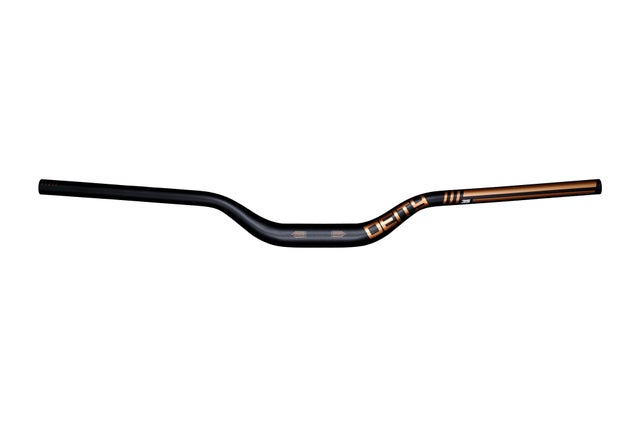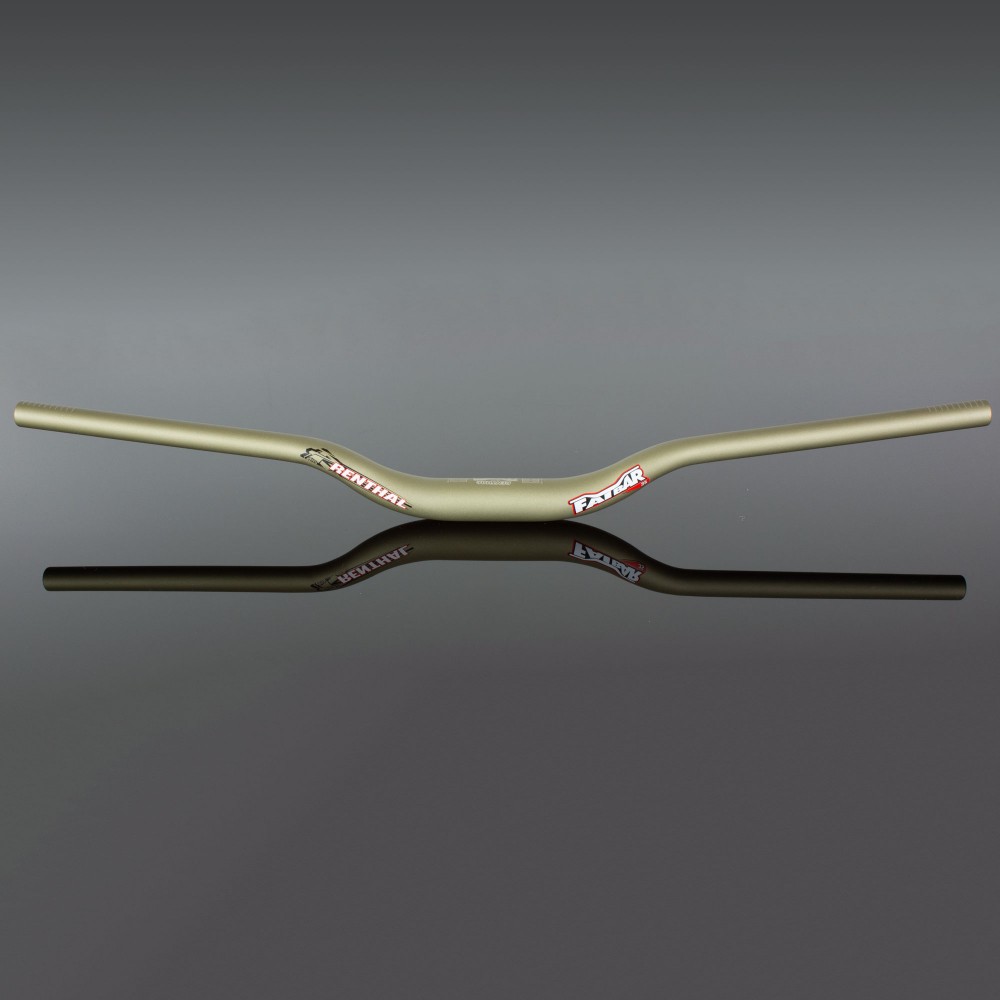Handlebars are a crucial part of your MTB riding experience; they should be comfortable, fit your body shape and position you correctly on the bike.
There are a wide range of handlebars to choose from. They can be made from either aluminum or carbon-fibre.

Material
A bicycle handlebar is the main control element of a bike. It provides a mount for a brake and shift lever as well as other accessories. It also helps to position the rider’s hands and body according to their riding style, providing a comfortable riding position.
Handlebars can be made from a variety of materials, including aluminium alloys, steel, carbon fibre and titanium. Each has a different purpose and characteristics.
Aluminium alloy bars are the most common, and they are typically lightweight, easily available in a wide range of designs and reasonably priced. They are a good choice for many riders as they provide a smooth, aerodynamic riding position and they have the ability to reduce road vibrations.
Titanium bars are another popular option, as they are slightly less stiff than most aluminium bars and weigh considerably less, while still being strong enough to handle the harshness of MTB use. However, titanium bars are significantly more expensive and are more difficult to produce, which is why they have taken a back seat to their more commonly used aluminium counterparts.
Carbon bars are the choice of a select few, as they offer the best combination of weight savings and compliance/damping characteristics. They also come with a more streamlined shape than their alloy counterparts, allowing riders to get the most out of their biking experiences.
These bars can be narrower than their straight bar counterparts, and they often have a cross brace for rigidity and strength. They are also more likely to be designed for specific uses, such as cross-country or downhill use.

Rise
Handlebars are one of the most vital contact points on a bike, so it is important to choose the right shape, size, and material that fits your needs. Choosing the wrong bar can make your ride uncomfortable and prevent you from getting the most out of your riding experience.
Most handlebars come in a range of sizes, shapes, and sweeps that can result in different levels of comfort, control, and on-trail performance. There are also a number of materials and constructions that produce varying degrees of vibration dampening, stiffness, and compliance which can reduce hand fatigue while enhancing control.
Carbon fiber handlebars are a popular choice for XC and trail riders due to their light weight and ability to take torsional loads well. Unlike alloy bars, carbon handlebars are more responsive to inputs from the rider and absorb trail chatter.
Renthal is a high-end brand that makes race winning bicycle components, including a full line of riser handlebars. They have been used by some of the most successful mountain bike racers in history, including Monster Energy Specialized’s Sam Hill, who won a World Championship downhill gold medal using a Renthal Fatbar.
Riser handlebars are a great option for cross-country and lightweight trail riders who want to get the most out of their weight over the front wheel. They can be a little more physically demanding, though, so it is important to know what kind of riding you intend to do on your new bar before making a decision.
Generally, aluminum is the most popular and affordable alloy for handlebars because it’s tough and durable and it can be very stiff if you need it to be. 0-degree carbon fibers are also a great choice for handlebars because they’re light and able to take the most bending loads without compromising strength.

Sweep
The sweep of the handlebars is an important consideration for bikepackers and long-distance mountain bikers. It allows riders to maintain good posture on their bikes and enjoy the ride more.
Sweep can also contribute to overall musculoskeletal health by encouraging the wrists to assume a more neutral, natural position. This promotes a comfortable riding position and reduces the risk of injury to the wrists, elbows, and shoulders.
Most modern mountain bikes come with relatively wide and straight handlebars. This type of handlebar can make it difficult to turn the bike in tight spots, which is often a concern for backcountry and long-distance riders.
Thankfully, the handlebar industry has made some strides in creating more comfortable options for trail riders. These bars typically have a 9-degree sweep or less and a subtle rise.
A higher rise is a great choice for pro downhill riders, but it’s not always necessary for beginners. You can find a handlebar that’s right for you by trying out different rise, width and sweep combinations before settling on the best one.
You can also experiment with stem lengths to see how your reach and front wheel placement will change. Changing the way your arms and hands are positioned will affect how you control the bike, so you might need to change the way you steer it as well.
As with all of our categories, the rise and sweep measurements will vary from brand to brand. This is largely due to individual preference, the geometry of your bike, and the terrain you ride.

Bar Width
Bar width is a personal choice, and it’s important to find the right width for you. It depends on body dimensions, local terrain, and riding style.
Wider bars offer more stability, especially on steep terrain. They also allow you to maneuver your bike more easily and stabilize the front wheel without expending as much energy.
While the law of diminishing returns says there’s a limit to how wide a handlebar can be, it’s still possible to find an ideal width for you. Start with a wide bar and trim it slowly in small increments until you find the right size for your riding style.
The bar’s material and construction affect the bar’s stiffness, compliance, and dampening characteristics. A bar with a high level of compliance tends to flex under pressure and can cause vibration, while one with a high level of stiffness stays stiff throughout the ride for improved control.
Handlebars are also designed with different rise and sweep angles that increase comfort, steering, and control. Sweep is the angle at which a handlebar extends back from perpendicular to the stem. The more upsweep a bar has, the more wrist rotation it gives and mimics the effect of a shorter stem.
Whether you’re looking to increase control, reduce hand fatigue, or both, there are handlebars for every need and rider. The key is to shop with the goal of improving your comfort and performance on the trails. This means choosing a bar that has the right geometry, rise, and sweep for your style of riding. It’s also important to remember that handlebars are designed to work with the frame and stem. They should never be used alone, and they should always be paired with a good stem.

Bar Diameter
The bar diameter is a key measurement to consider when choosing the right handlebar. It can be an indicator of stiffness and compliance, which can affect how your hands feel in the saddle.
Some riders like to have very stiff bars that maximize control and steering input on the bike, while others prefer a more compliant bar that absorbs trail feedback and reduces hand fatigue. The best bars will provide the best balance of stiffness and compliance for each rider.
This is why it’s important to take into account the size of your bike and the type of riding you do. A shorter and stocky rider will probably need a narrower bar than someone with a longer and slender build.
A curved handlebar shape can help with handling in rough terrain, while a straight bar can cause wrist fatigue and pain in the hands. However, there’s no hard and fast rule on what a good handlebar shape should be, so it’s important to experiment with different shapes until you find the one that works for you.
Typically, mountain bike handlebars are 7/8″ (22mm) or 1″ (25mm) in diameter, and can also be stepped or tapered for added flex. This diameter is common for flat bars, riser bars and some porteur bars.
If you’re unsure of the diameter, use a pair of calipers or visit your local bike shop to get the measurements. They’ll be able to tell you if you need a shim or not, as well.
There are three key measures to take when looking at the bar diameter: rise, sweep and bar width. These will vary slightly from one bar to the next, but should give you a solid starting point for what size to look for.